
There are many traditions associated with lace knitting – I am going to start with the tradition that I am most familiar with –
Shetland Lace Knitting.
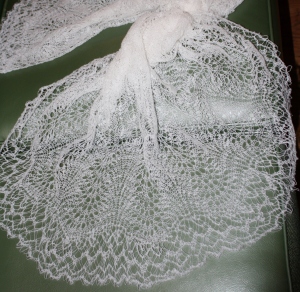
If you are a knitter with a Western European background you are probably very familiar with Shetland Lace Knitting. This is the knitting that can be so fine that it can be drawn through a ring. This is the knitting of “Hap” Shawls. This is the knitting of crofters of Northern Scotland and the Shetland Islands.
There are many books on the topic of lace knitting – many of them focus on Shetland Lace Knitting in particular.
- Sarah Don – the Art of Shetland Lace
- Gladys Amedro – Shetland Lace
- Carol Rasmussen Noble and Margaret Leask Peterson – Knits from the North Sea
- Sharon Miller – Heirloom Lace Knitting
- Shetland Guild of Spinners, Knitters, Weavers and Dyers – A Legacy of Shetland Lace
- Elizabeth Lovick – The Magic of Shetland Lace Knitting
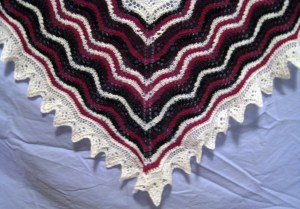
These are just a few of the books out there, some like the Art of Shetland Lace have been around a while; and the while the newest, The Magic of Shetland Lace Knitting is fabulous, A Legacy of Shetland Lace, by the Shetland Guild of Spinners, Knitters, Weavers and Dyers is considered to be the most authoritative. I find that they each have something to offer. In particular, the stitch library from Heirloom Lace Knitting is incredible.
Wedding Ring Shawls – the finest of the lace
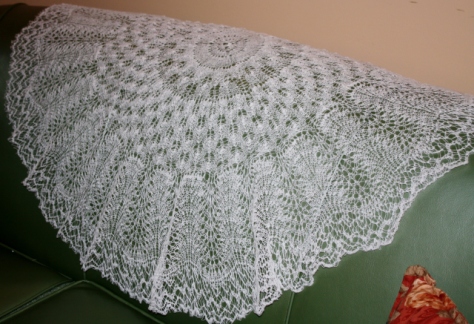
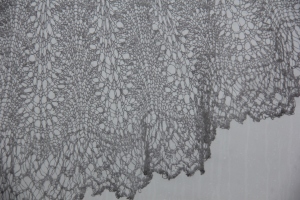
Knit with the finest fibre from the sheep – said to be from the head and neck – this yarn is spun so fine that once knit a large wedding shawl can be drawn through a wedding ring. One of these shawls may weigh less than 100grs and be close to 72 inches square.
These “Ring’ shawls were usually very elaborate and highly prized; they were often spun and then knit by the same person. The skill to spin the yarn so fine and then knit a shawl would be incredible! The best spinners could spin 9000 yds from an oz of wool! Those spinners were usually older women with many years of experience.
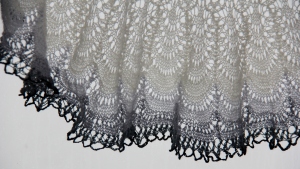
These shawls were also usually lace knit in that there were no plain rows – every row patterned and elaborate. The designs would fill the center of the shawl as well as the borders and edgings, unlike the plainer, hap style shawls.
Christening Shawls
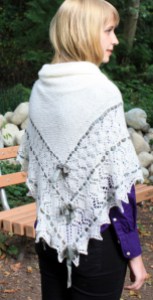
These shawls would often have elaborate borders and edgings, but the center would be very simple, just a small style of pattern or solid garter stitch. They were not knit in the cobweb weight of yarn, they were more usually knit in the 2-ply weight.
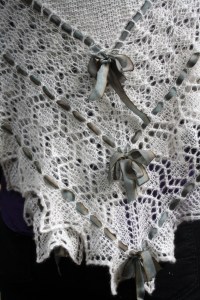
These shawls were meant to wrap babies and keep them warm. Quite often for the baby they would only be lightly stretched, and after the shawl was no longer needed for the baby it could be more severely blocked so that it could then be worn by the mother.
Nowadays, Christening Shawls are heirloom items, made for only the one purpose and then saved for the next baby.
Hap Shawls
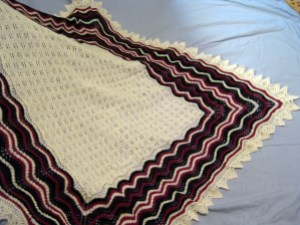
This “everyday” shawl was worn by most. Knit in 2-ply wool with solid or simple centers and usually striped edges, these shawls were worn until they wore out.
The lace patterning in the border was quite often the Feather and Fan pattern, usually striped. Striping is a great way of using up bits of left over colours and looks quite beautiful.
Hap shawls could be square or round, but were usually square, and just the size to fit a blocking frame. Blocking Frames were large wooden squares, lined with nails. String was run through the points of the edging and then strung around the nails and pulled tight to allow th shawl to dry square and with every point sharp.
My Hap style shawl was knit with my Grandmother in mind. It too has a story.
The Construction and Structure of a Shetland Lace Shawl
Shetland lace shawls – square or round – were always started from the center and worked out.

1) Center – knit from point to point.
2) Pick-up stitches for border.
3) Borders – knit out from center.
4) Edging – knit around borders.
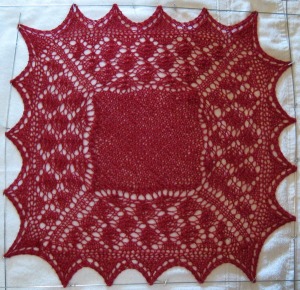
The center square could be worked straight up from the cast-on to cast-off in garter stitch or in pattern; or it could be worked from point to point, starting with just one stitch and increasing on every row until the square was wide enough and then decreased back down to a single stitch again.
A baby’s Christening shawl would have a solid garter center or a simple pattern only. A complex shawl for a wedding or ring shawl would be knit in complex knitted lace patterns.
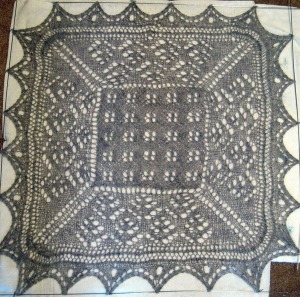
From the center square the borders were picked up and worked outwards. It used to be that the border for each side was worked separately, increasing the stitches on each end for shaping and then joined with a special seaming technique.
Most modern knitters use a circular needle and knit the border on in the round in one piece, using a yarn-over seam to create the corner shaping – eliminating those seams.
The border patterns can be simple or complex depending on the knitter or final use of the shawl – ie for a baby or for a wedding!

From the border section the edging is knit on. The edging usually starts with a provisional cast-on and once the edging is finished the two ends are grafted together. These edgings can be simple points or much more elaborate extensions of the lace patterning’s of the shawl center and borders.
The knit-on edging also works as a bind-off as each live stitch of the border is knit into the edge.
A Shetland Knitter – Anne Williams
I met Anne at Mad About Ewe’s retreat with Abbott Smith last year, 2013. I may have talked to her in the store before that, but I really started to know her at that time.
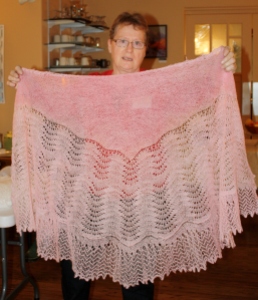
Just before the Retreat 2013 I had blogged about Lace knitting and Knitted Lace and was just starting to create the blog you are reading now. Meeting Anne completely knocked me over. Why? Because Anne brought to the retreat the most amazing Shetland Lace Knitting to show and tell. I wanted to learn more about Anne and her knitting.
Anne came to the Brioche and Lace Retreat this year and we sat down and had a conversation about her knitting.
Anne Williams currently lives in the Shuswap area of British Columbia, but is originally from Northern Scotland – you can still hear the soft brogue in her voice.
Anne cannot remember a time when she didn’t knit. Her earliest memories include holding needles in her hands – they were long steel pins, anchored into the horse hair filled sheath at her waist. Her Grandmother taught her to knit. But the story starts with Anne’s Great-Grandmother.
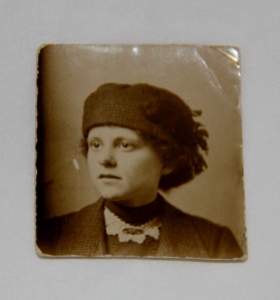
Anne’s Great-Grandmother Janet was from Unst, the northernmost of the Shetland Islands. She left the Island at 16 and never returned but Janet brought with her an amazing skill – Lace Knitting. Janet had 8 daughters and one son. They all learned to knit lace and fair isle. Their children all learned to knit as well. And their children all learned to knit. Anne was one of those last generation of children. They all learned to knit, lace and fair isle, boys and girls.
Anne grew up around Fort William but spent the Winters in Glasgow with her Grandmother and learned all the needle skills. She had a very Victorian training from her Grandmother, including learning how to curtsey properly. The knitting has stayed with her.
Anne’s daughters do not know how to knit, but Anne, like her Grandmother, has taught two of her granddaughters, one eight, one twelve how to knit. Knitting is part of her heritage and she does not want to see it die out in her family.
Anne is just about to start her own version of a “Legacy” shawl – something beautiful and stunning, a rare example of extreme skill. A large Shetland Square, knit on 2.0mm needles with Gossamer Cashmere from Heirloom Knitting. This yarn is only the thickness of a hair. There are over 1100m in 25grs of the cashmere and this is a 2 ply yarn – can you imagine the original single ply!?
Anne will be using the Queen Susan Shawl as her template for designing. Anne has Sharon Miller’s book Heirloom Knitting (see above) and will pick her own patterns to fill in the sections of the shawl, but use the basic shape and structure of the Queen Susan Shawl. I am looking forward to seeing how this project progresses!
Everything Else Shetland
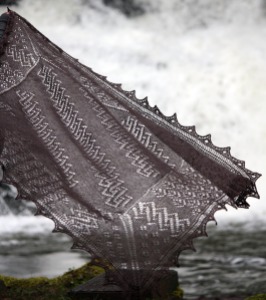
Shetland lace knitters have knit a wide variety of items, from the famous shawls to christening robes, stockings and stoles, scarves and clouds. Clouds, I was fascinated to discover, are lace wimples or cowls. If you visit Ravelry there are many examples of lace items that have been inspired by the traditions of Shetland Lace Knitting.
From the Shetlands also come strong Fair Isle Knitting traditions – but that will be for another page!
Happy Lace Knitting
Lynette

